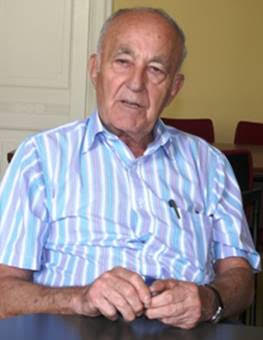
THE VOICE OF INTERNATIONAL LITHUANIA
|
VilNews has its own Google archive! Type a word in the above search box to find any article.
You can also follow us on Facebook. We have two different pages. Click to open and join.
|
Archive for July, 2011
Hitachi-GE wins Lithuanian nuclear tender
- Posted by - (0) Comment
![]()

Having been selected as 'strategic investor' for the Visaginas nuclear power project, Hitachi-GE is expected to build a nuclear power plant there for operation in 2020.
An announcement at the start of June revealed that Lithuanian officials had invited both Hitachi-GE and Westinghouse to submit proposals for Visaginas, which is to be a new power plant to replace generation lost with the shutdown of Ignalina.
After six weeks of consideration, the Ministry of Energy has today said that the evaluation commission has selected Hitachi-GE's proposal, based on the Advanced Boiling Water Reactor. Plans are for a single unit producing about 1300 MWe to begin operation from about 2020.
Partners in the project, Estonia, Latvia and Poland, participated in the evaluation, which encompassed a wide range of factors to determine which of the two proposals was the "most economically advantageous."
Some site preparation work has already taken place at Visaginas, and it already holds positive verdicts on environmental impact assessment and site suitability. The site is close by to Ignalina, where two large RBMK units built in the Soviet era provided some 2370 MWe, setting Lithuania's share of nuclear energy at 70% and giving healthy supply of power for export.
Visaginas is one of several active nuclear projects in the European Union. Single reactors are currently under construction in Finland and France, with more at the planning stage in each country. Two units are nearing completion in Slovakia, while plans for new build are maturing in the Czech Republic, Romania, the Netherlands and the UK.
Source: World Nuclear News
- Bookmark :
- Digg
- del.icio.us
- Stumbleupon
- Redit it
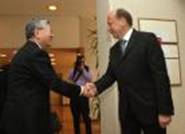
On 16 June a delegation led by Hitachi President Hiroaki Nakanishi introduced its bid to invest in Visaginas NPP project during a meeting with the Government of the Republic of Lithuania and the Commission for the Implementation of the New Visaginas NPP Project. Hitachi, together with one of its subsidiaries, Hitachi-GE Nuclear Energy.
“Our aim is to ensure that development of Visaginas NPP complies with all the international and nuclear safety requirements. Therefore we are delighted at this opportunity to welcome Hitachi, the top-level technology company, to Lithuania; this company has expressed its interest to participate in this project as a strategic investor”, said Prime Minister Andrius Kubilius.
Kubilius also noted that the fact, that it was President of Hitachi Group himself, who had introduced his company’s bid and showed his active involvement in the entire project environment, demonstrated very serious intentions by the potential investor, as well as recognition of Visaginas NPP project soundness.
“Lithuania would be interested in Hitachi’s investment not only into the nuclear power, but also in other sectors, especially high technologies, in our country”, said Kubilius after his meeting with the President of Hitachi.
During its visit in Lithuania, Hitachi delegation also met with representatives of the regional partners of Visaginas NPP project from Estonia, Latvia, and Poland, as well as the European Commission representatives.
The regional Visaginas NPP project is among the most progressive new nuclear power plant projects in Europe. Major part of the preliminary work for the project has already been completed, including the environmental impact assessment, which is in compliance with the ESPOO Convention, and the assessment of the site suitability; conclusions of both assessments were confirmed by expert missions from the International Atomic Energy Agency (IAEA) as well.
It is planed that construction work for Visaginas NPP will start in 2014, and the plant is to start generating power as of 2020.
- Bookmark :
- Digg
- del.icio.us
- Stumbleupon
- Redit it
![]()

Jurate Kutkus Burns
On my first visit to Lithuania in 1998 I was struck by 2 major differences between the language I heard spoken at home in the USA and that which was spoken in Lithuania.
My parents pronunciation was much softer, and did not have that hard Slavic edge I heard spoken by young Lithuanians. Also, there were lots of vocabulary words unfamiliar to me.
Jurate Kutkus Burns, Florida
- Bookmark :
- Digg
- del.icio.us
- Stumbleupon
- Redit it
- Posted by - (0) Comment

Welcome to Klaipėda!
Klaipėda is Lithuania’s third biggest city, situated at the mouth of the Curonian Lagoon to the Baltic Sea. It is Lithuania's only seaport, with major ferry connections to Sweden, Denmark and Germany. Throughout its history, the town has belonged as Memel to Prussia and Germany, and since 1923 as Klaipėda to Lithuania. Some of its older buildings have picturesque frameworkarchitecture similar to that found in Germany, England, and Denmark. The population shrank from 207,100 in 1992 to 187,442 inhabitants in 2005. Popular seaside resorts found close to Klaipėda are Nida to the south on the Curonian Spit, and Palanga to the north. The port of Klaipėda handles some 20 million tons of cargo each year.
From 1252–1923 and from 1939–1945 the town and city was named Memel; between 1923 and 1939, and since 1945, it has had the Lithuanian name of Klaipėda. Memel is found in most sources from the 13th century, while Klaipėda is commonly used in Lithuanian sources from the 15th century. The former notion that Memel is a place-name of German etymology is argued by Lithuanians to be contradicted by their evidence that the lower reaches of the Neman River were named either Memele or Memela by local inhabitants. The name "Klaipėda" is seemingly a Samogitian appellation which may refer to the boggy terrain of the town.
www.klaipeda.lt
www.klaipedainfo.lt
www.investinklaipeda.com
www.fez.lt
„At the beginning there was a sea and a coast. Then, contours of a castle showed up in the swampy ground, in the lower reaches of the river. And a windborne city – as open and unpredictable as the horizon – sprang up.
- Opening phrase from the booklet „Signs of culture in Klaipėda“
- Bookmark :
- Digg
- del.icio.us
- Stumbleupon
- Redit it
The Lithuanian language – past, present, future
- Posted by - (9) Comment
Vin Karnila, Associate editor
vin.karnila@VilNews.com
There are many articles written about the Lithuanian language. Some of them focus on the Indo-European / Old Sanskrit origins of the language, some delve into the complexities of the language and some are written for the understanding of the linguists. What attracted my attention to this article was that this is one of the best articles I have come across that gives a clear and easy to understand report on how the Lithuanian language evolved into what it is today.
This article was written by Giedrius Subačius, who is a member of the Institute of the Lithuanian Language located in Vilnius. The Institute of the Lithuanian Language itself is something to take note of. The institute holds the high status of a state research institution of the Republic of Lithuania. It is the center for scientific research of the Lithuanian language. Currently it has over 100 employees with over 70 of them taking research positions.
The main activities of which are the following:
1. Lexicology, lexicography, and research into the grammatical structure of the Lithuanian language;
2. Research into the history and dialects of the Lithuanian language, and sociolinguistic research;
3. Research into the operation of the Lithuanian language in society, and into terminology;
4. Research into Lithuanian onomastics.
The main work of the Institute of the Lithuanian Language:
1. The preparation of the Dictionary of the Lithuanian Language (in 20 volumes) and its computerised version, the accumulation of a computerised database of the Lithuanian lexicon.
2. The preparation of the Dictionary of the Standard Lithuanian Language.
3. The compilation of an academic grammar of the Lithuanian language, research into the evolution of Lithuanian syntax.
4. The gathering of data on and research into Lithuanian dialects, the preparation of an atlas of European languages.
5. The evolution and development of the written Lithuanian language, and the compilation of a database of old Lithuanian writings.
6. The analysis of the development of the norms and terminology of the Lithuanian language, and the compilation of a database of linguistic phenomena and their assessment.
7. The preparation of an etymological dictionary of Lithuanian toponyms, and research into toponyms and personal names in Lithuania.
Quite impressive!!!
For more information about the Institute of the Lithuanian Language please visit
http://www.lki.lt/LKI_EN/

So now let us share with you this very interesting and informative article written by a person from an institution that is highly qualified in this subject.
The Lithuanian Language
By Giedrius Subačius
Due to their similar political situations 20th historical development in the 20th century, the three Baltic States - Estonia, Latvia and. Lithuania - are often treated as sisters, and referred to as Baltic countries. This name is even applied to the entire region. But professional linguists have always pointed out that this is not an appropriate designation. The term Balt was coined in the 19th century by the German linguist Ferdinand Nesselman to name one of the branches of the Indo-European languages spoken on the eastern shores of the Baltic Sea. Linguists had already known Indo-European groups such as Germanic, Romance and Slavic; now they discovered another group of Indo-European languages, the Baltic languages. Since then, in linguistics, the term has been applied only in reference to the true Baltic languages: the living Lithuanian and Latvian languages, and dead languages such as Curonian, Semigallian, Selonian, Yotvingian and Galindan. For the Balts, the early 13th century was when they emerged from oblivion to enter European history and become permanent participants in it. This was the time when the two German orders, the Teutonic and the Livonian Order, first appeared on the territories inhabited by the Balts and slowly settled in the areas of the old Prussian and Latvian tribes. It was the time when the pre-Christian Lithuanian state emerged, capable of defending itself against the militant neighbouring orders. The present-day Lithuanian nation was formed mainly from the Lithuanian and Samogitian tribes, but included Semigallians, Curonians, Sudovians and Yotvingians. The Lithuanian state, which emerged in the middle of the 13th century, has retained to this day these lands as the core of its territory, although the history of Lithuanianstatehood has been very volatile. In the 13th to the 16th centuries it stretched over large areas inhabited not only by Balts but also by Slavs. From the mid-16th century to the end of the 18th century it was in a union with Poland. From the end of the 18th century to the early 20th century the Russian Empire occupied it. From 1944 to 1990 it was occupied by the Soviet Union. Since 1990, Lithuania has again been a democratic independent republic, like Latvia and Estonia.
Lithuanians make up about 80 per cent of the population of Lithuania. This means that more than three million people (perhaps three and a half million) consider Lithuanian to be their mother tongue. It is spoken by the autochthon Lithuanian populations in some border areas of Poland and Belarus, and by numerous Lithuanian émigrés in other countries. The largest émigré groups are to be found in the United States.
People have long been curious to know what makes languages similar, and why people speak different languages in different countries. Linguistic similarity could be evidence of a tribal or national affinity, or even prove the place closest to God. For instance, during the Renaissance one similarity theory held that Lithuanian was simply a debased Latin, and we know that Latin was the most sacred language in the Catholic world. Genealogical studies of languages took on a scientific approach only in the 19th century. Traditionally, it was based on the history of sounds: that is, it was a history of the spoken language, which people learn in some mysterious way in early childhood without any apparent effort, as if the sounds of the language overwhelmed them like a swollen river.
Latvian is the only living language with sounds and endings similar to those of Lithuanian, but a Latvian and a Lithuanian who do not speak each other's tongue cannot communicate, unlike a Dane who can communicate with a Norwegian, an Italian who can communicate with a Spaniard, or a Ukrainian who can communicate with a Russian. A Lithuanian and a Latvian can only recognise a few words in each other's speech, and this is not enough to hold a conversation. Therefore, we can say that Lithuanian is a language that cannot be understood by a speaker of any other language who has not learnt it. More than that, even users of different Lithuanian dialects (such as Samogitians and Aukštaitians) cannot understand each other unless they communicate in standard Lithuanian, which they, have to learn.
Since the 19th century, when the similarity between Lithuanian and Sanskrit was discovered, Lithuanians have taken a particular pride in their mother tongue as the oldest living Indo-European language. To this day, to some Lithuanians their understanding of their nationality is based on their linguistic identity. It is no surprise then that they proudly quote the French linguist Antoine Meillet, who said, that anyone who wanted to hear old Indo-European should go and listen to a Lithuanian farmer. The 19th century maxim - the older the language the better - is still alive in Lithuania.
The history of sounds explains how the Lithuanian word sūnus and the German Sohn, English son, and Polish syn are not loanwords from one language to another, but have the same origin. The same is true of the Lithuanian duktė, German Tochter, English daughter, and Polish corka.
This genealogical history of sounds is like a biological science: tracing DNA sequences is like tracing and reconstructing sound sequences. Thus, we can say that throughout the centuries, the changes in Lithuanian "DNA sequences" have been less numerous than in other languages, and that is the reason why it is considered to be a very old language.
The social history of the Lithuanian language can be considered in the context of its relations and contacts with other languages. For a number of centuries, contacts were especially close with two living languages, German and Polish (in addition to Latin and the East Slavic written languages).
Lithuanian has come into contact also with Yiddish, Russian and other languages, but these contacts have left fewer traces.
Lithuanian culture in East Prussia was strongly influenced by German culture. From the 16th century until the middle of the 20th century, East Prussia produced a large number of Lithuanian books: translations of the Bible, psalm books, grammars, dictionaries and primers, including the first Lithuanian translation of the Bible (by Jonas Bretkūnas [Bretke] in around 1590-1602) and the first Lithuanian grammar (by Danielius Kleinas in 1653). In all of these activities, Lithuanian was in close contact with German. The first Lithuanian manuscript of the Bible was mostly a translation of Luther's translation; the second Lithuanian grammar was written and published in German (in 1654); a large number of psalms in the 16th century were translated from the German; and all or almost all of the bilingual dictionaries (there were no monolingual Lithuanian dictionaries) known since the 17th century were either German-Lithuanian or Lithuanian-German.
At the time that Lithuania formed a commonwealth (federation) with Poland (1569 to 1795) and when it was occupied by the Russian Empire (1795 to 1914), the Lithuanian language in Lithuania proper was under the influence of the Polish language. In the middle Ages, Lithuanian dukes and gentry spoke Lithuanian; but during the Renaissance they switched to Polish. Gradually, Polish became the language of culture. It is for this reason that nowadays Lithuanians sometimes take more pride in their, older dukes, who spoke Lithuanian, and cannot fully accept the later ones who could not. The dominance of the Polish language meant the introduction and use of Polish letters: the digraphs sz and cz for š is and č respectively in modern Lithuanian, and the letters 1, z, i and s.
At the end of the 19th century, however, neither of the two written traditions (Prussian or Polish) would form the foundations of modern standard Lithuanian. The national movement wanted to standardize the language in such a way that it would be different from other languages in the area. The Lithuanians rejected the Polish letter 1, refused, to accept the German and Polish w, and replaced cz and sz with the Czech č and š. In the end, standard Lithuanian became established in Lithuania; while in East Prussia the language has disappeared, together with German, to give way to Russian in the newly emerged Kaliningrad Region. Still, some elements of the writing from East Prussia were transferred into standard Lithuanian, such as the letter ė, the use of the letters i and y, and the majority of the case endings.
It is interesting that these letters became an, integral part of the spelling at the same time as the, Lithuanian (or Latin) letters were prohibited by the Russian authorities. The late development of standard Lithuanian has been responsible for some of its modern features. For instance, ą, ę, į, ų, ė, č, š, ž, ū are relatively new additions to the Latin alphabet.
Modern though they are, all these additions to the Latin alphabet are a nuisance to foreigners. These diacritical marks, or accents, to them are like background noise in a recording of music, or a spot of fat on a clean tablecloth: an unavoidable nuisance, to be ignored in order to avoid irritation. Foreigners have to study long and hard to understand why in Lithuanian dictionaries the word cinikas (a cynic) comes before čekistas (a Chekist).
Another problem is that with the advent of the Internet the old Latin alphabet, which has been preserved and used in almost its original form by the English language, is seen as the most modem alphabet.
It is true that, in the last few years, the developers of universal fonts, Internet browsers and e-mail programs have made great efforts to show more respect to these letters, to make them convenient to use and safe against discrimination in any way.
Lithuanians are always pleasantly surprised and glad to meet a foreigner who has learnt some of their language and is familiar with their special letters. It is gratifying to hear a foreigner speaking Lithuanian, because that is not a skill commonly found beyond the country's borders, and Lithuanian has never been widely taught as a foreign language.
To a person who is familiar with old Indo-European languages such as Latin or Ancient Greek, Lithuanian grammar will come more easily than to a person who can speak modem "English, Spanish, Italian, French or German. Due to the old features of Lithuanian grammar, most foreign students find it a very difficult language to learn. It is frustrating to have to learn five declensions, each with seven cases, both in the singular and the plural. The very concept of an ending is difficult to grasp if a person speaks only English. Some learners are frustrated by the mobile stress in different forms of the same word, which sometimes outwits even the native speakers.
On the other hand, the late development of standard Lithuanian offers certain advantages to learners of it. Even native speakers believe that the pronunciation is almost entirely consistent with the spelling: that is, that the words are pronounced exactly as they are spelt. One letter usually corresponds to one sound. In this respect, Lithuanian is more modern than French or English, where the same letters do not always represent the same sound.
Due to the structural peculiarities of their language, Lithuanians themselves experience various difficulties in learning other ones. For example, they find it difficult to master the use of articles in English, German, Italian, and French, because in Lithuanian there are none. The concept is rendered by other means, such as definite or indefinite adjectives: The White House is Baltieji Rūmai: The word order in a Lithuanian sentence is quite free, and is a convenient means to express a variety of nuances. Therefore, when learning English or German, Lithuanians are inclined to 'improve' the syntactic constructions of these languages by 'liberating' the word order.
Everybody knows that Lithuanian has a variety of colourful swearwords: for example, rupūžė! (toad), rupūs miltai! (coarse flour), kad tave sutrauktų) (I wish you were contracted). But when a Lithuanian is truly angry, a foreigner may be surprised to hear Russian or English swearwords escaping his lips. In the speech of town dwellers, probably the most popular Lithuanian swearword is velnias! (Devil), but in a Catholic country the reasons for its being a swearword should be evident.
In contrast to Soviet times, the Lithuanian Constitution stipulates that "the Lithuanian language is the official language of the Republic of Lithuania.” This means that it must be used in all areas of public life. The country has a National Commission for the Lithuanian Language, responsible for monitoring and correcting the use of it. It even has the right to impose fines for certain mistakes in public advertisements. On the other hand, efforts are still being made to preserve the languages of minorities, Russian, Polish, Belarusian, etc.
What do Lithuanians think is the future of their language? Some believe that with the disappearance of Soviet unifying policies, the area of use of the language has expanded and they are happy about this. They are also aware of the dangers posed to the survival of the language by the country's integration into Europe. On the other hand, the number of Lithuanians learning foreign languages is constantly increasing, because everybody understands that Lithuanian alone is not sufficient for effective communication in the world.
- Bookmark :
- Digg
- del.icio.us
- Stumbleupon
- Redit it
Gazprom denies Lithuania ‘political’ price claims
- Posted by - (0) Comment

Gazprom spokesman
Sergei Kupriyanov
Russian giant Gazprom on Wednesday hit back at claims by Lithuania's president that the gas prices it applied for the Baltic state are were political and not based on economics.
"Lithuania's gas prices are not political," Gazprom spokesman Sergei Kupriyanov said in a statement released in the Lithuanian capital Vilnius.
"They are the result of a gas pricing formula which was agreed between our Lithuanian partners -- including the Lithuanian government -- and Gazprom back in 2004," he said.
On Tuesday, Lithuania's President Dalia Grybauskaite had fired a new shot in a verbal war between the nation of three million and Gazprom, its sole supplier, suggesting it was being treated unfairly.
"Gazprom's prices have a political character, not an economic one," Grybauskaite said.
"The difference in price for Lithuania and on global markets has a purely political tone," she added, blaming "the attitude of Russia's leaders towards cooperation with Lithuania."
In January Lithuania asked Brussels to probe Gazprom for allegedly abusing its market clout in the 27-nation European Union.
The price set in Gazprom's supply deal with Lithuania is confidential, but Grybauskaite has estimated that it pays 30-40 percent more than Germany, for example.
But Kupriyanov rejected the charges.
"The principle of this (gas-pricing) formula is by no means used only in Lithuania, but in all European countries," he said.
"The gas price in Europe can vary between different buyer countries and may change at different times within a signed contract," he explained.
"All of this is pure economics and has absolutely nothing to do with politics. Lithuania must be well aware of it," he added.
Lithuania's reliance on Russia for gas is a legacy of five decades of Soviet rule, which ended in 1991. Lithuania joined the EU in 2004.
Read more at:
http://www.google.com/hostednews/afp/article/ALeqM5haAHGhobpcNwnqavK3bFAv9cnn9g?docId=CNG.672921cf040c5c718fe8bdbe7ea930e8.1b1
- Bookmark :
- Digg
- del.icio.us
- Stumbleupon
- Redit it
- Posted by - (2) Comment
Shale gas:
Energy security laced with possible ecological calamity
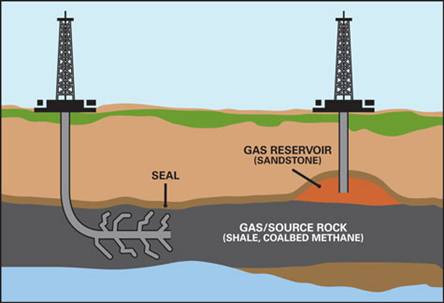
Prepared by: dr. Stasys Bačkaitis, P.E., SAE Fellow
In the last few years, the world's gas markets have and are still experiencing a revolution. Thanks to the newly developed U.S. technology, that allows drilling into shale formations and breaking them apart for extraction of gas, knowledge on how to tap into such gas resources became available to any country in the world. -This process, allowed the United States today to supply more than 23% of its internal gas needs and increase it to 40% in approx. 5-6 years. U.S. success, led many other countries to start searching for and extracting gas in their own territories. The result is a substantial decline in gas prices. Increased supply of gas and its transportation in liquefied form have become so plentiful that the United States, which had previously imported it, now began its massive export. Gas reserves are expected to increase globally in the foreseeable future at least 4% per year.
Gas extraction from shale deposits
Geologists have known for a long time about shale rocks containing gas deposits. However, the technology to reach them and to extract gases from the deposits was developed only a few years ago. In this process, rocks are drilled vertically to depths of several thousand meters. Once the desired layer of shale rock is reached, the drill head is oriented to continue drilling horizontally several kilometers away of the vertical. After the necessary underground targets are prepared, pipes are inserted into the drilled out boreholes and reinforced on the outside by blown-in concrete. Subsequently, the pipes are pressure filled with a special liquid mixture. The shale rock is penetrated by pulsating thrusts of the pressurized liquid through special openings in the pipe. As a result of the pulsating pressure, fissures in the shale rock develop and keep expanding until a desired penetration level is reached. During the expansion, sand is injected into the fissures to prevent their collapse. Upon relief of the water pressure, the compressed liquid mixture, now containing gas, shoots out like champagne from a suddenly uncorked bottle. Escaping gases are then directed by special devices to gas storage facilities.
A special liquid mixture is used in the drilling and gas extraction process. It involves millions of gallons of water, mixed with sand and special chemicals, which facilitate drilling, reduce pipe corrosion, etc. Although the chemicals are only ½ per cent of the injected liquid mixture, most of them are toxic and dangerous to human health. If an unexpected equipment breakage were to occur during the drilling process, underground spillage of the special mixture could contaminate the penetrated aquifers. Similarly, any spillage and leakage from holding ponds containing used drilling liquids could contaminate the entire region’s drinking waters. They are extremely difficult, if not impossible, to neutralize, because in many instances the content of the chemicals in the drilling mixture is proprietary, different with each driller, and not readily disclosed even to the regulating authorities. Shale gas drillers are now under extreme pressure by environmental and public health departments and community organizations to improve the gas extraction methods and to find safe for human health substitutes for toxic chemicals.
Resources in Lithuania
For a few weeks now, Lithuania’s government has been making public announcements about shale gas deposits in Lithuania. While their existence has been known for a long time, only the development of horizontal drilling and fracture technologies of shale deposits has brought a glimmer of hope of extracting gas for the country’s own use. The news of these gas resources has created considerable public interest and enthusiasm for attaining energy self sufficiency. It has become even more relevant, when Lithuania’s energy minister Sekmokas, while visiting Washington, D.C. in May of 2011, was informed by the U.S. Energy Information Resources Agency director, Richard Newell, that the south-western region of Lithuania may indeed contain significant shale deposits. Minister Sekmokas, upon his return from Washington, announced that shale deposits in Lithuania might be sufficient to supply the country’s energy needs for 30-50 years. If true, it would completely change the energy situation in Lithuania and help to attain energy security for a long time to come.
It seems that discussions about shale gas resources in Lithuania have a good foundation. Consultants on shale gas deposits note, that Poland has most likely the largest shale deposits in Europe. They extend from the entire north coast of Poland to its distant southeast border. They could contain over 5 trillion cubic meters of shale gas. Some of these deposits extend into the south-western and western regions of Lithuania. Preliminary data indicate that 1 square km of shale rock area will yield about 390 million cubic meters of deliverable gas. However, currently there is virtually no knowledge of how many square kilometers of shale rock are within Lithuania’s territory. The energy ministry noted that further drilling and testing will be conducted to make appropriate assessments.
Promise of bountiful energy and potential environmental risks
Although the first indications of bountiful energy supplies are received by cheers from shale gas fans, the euphoria, however, is laced sometimes by subdued warnings that cheap and bountiful gas might be just an unjustifiable and unrealizable illusion. The murmurs are even uttered even by some Western experts and analysts. There are several reasons for this:
1. In depth research of shale deposits by U.S. geologists cover in good depth primarily the territory of the United States. Their knowledge about shale gas formations in other parts of the world are more theoretical deductions based on a relatively limited number of explored wells. Although news about the potential shale deposits in Lithuania are much welcome, they will need to be supported by concrete evidence from deposits extracted from drillings of hundreds of exploratory wells. Potential resource assessment may take two, three, even four years. Only then will it be possible to assert which of the areas have formations with sufficient amounts of gas, and if there are opportunities to extract it at a reasonable price. It should be noted that not all shale formations contain gas. Past experience has shown that dozens of exploratory wells yielded not even one cubic foot of gas. Drilling does not always hit the sweet spot of high gas concentration, or it might find low levels of concentration that would not justify commercial extraction. Inasmuch as initial exploratory wells cost between three and eight mln. USD, drillers have to be fairly certain that the intended exploration area is large enough and has sufficient gas yield potential to justify initial research expenditures.
2. The greatest risk of extracting gas from shale deposits is contamination or even poisoning of drinking water resources. Contamination of water resources can occur during the drilling process towards the shale formation, through the escape of gas and/or drilling liquids via alternative paths after fracturing the shale rock, by bursts of underground pipes, or by pipe connection defects. Theoretically, ground water contamination by diluted mixtures of chemicals can be avoided since most ground waters are considerably above the shale rock deposits. However, drilling and gas extraction processes are not hermetically sealed operations, rock formations have voids, and mistakes and accidents do occur. In such cases leakage, seepage and underground spills can have serious consequences. According to U.S. media, drinking water contamination problems have been encountered at a number of drilling sites in the Marcellus formation region, encompassing Pennsylvania, Ohio and West Virginia regions, an area of approximately 250 thousand square kilometers. The contaminations involved, in some instances, ground waters, and in others streams and rivers. The media also cited a growing number of complaints by area residents of unexpected and strange health problems, death of animals grazing in meadows in the vicinity of drilling sites, and even ignition of water flowing out of kitchen faucets. Environmental authorities observe that the current water treatment systems have great difficulty coping with the contaminants, since they are numerous and many times unknown. According to the Texas environmental agency, of 37 shale gas wells tested for contaminants, 13 were found containing toxins considerably higher than allowable tolerance limits for human health. As a result, a number of gas well operations were terminated by orders of Pennsylvania and New York state health authorities. The state of New Jersey adopted a law in July 2011, prohibiting shale gas extraction in the entire state, until the license applying operator provides evidence that any materials used in shale rock drilling and fracturing processes will be absent of ingredients posing risk to human health. Similar legislation was also adopted by France. The city of Pittsburgh, Pennsylvania, as a result of contamination of its aquifer, advised its inhabitants in spring of 2011 to avoid use of city supplied water for drinking and food preparation
3. Underground shale gas production consumes significant amounts of water that is lost forever. In areas where availability of water resources is critical or is not in abundance, water scarcity could develop for human needs, particularly if the water for the extraction of shale gas is drawn from underground aquifers. Each repeated fracturing operation consumes some 13 million gallons of water which can in some areas deplete local reservoirs. Accordingly, Energy Business Insider notes, the notion that shale-gas could become the next gold rush may be jeopardized, particularly because its production in some regions might conflict with human needs. In other instances shale gas extraction may be impossible due to unavailability of water. As demand on water resources grows, it will become an important consideration in the shale gas energy agenda alongside cost, carbon and security considerations.
4. According to the U.S. Energy Department estimates, Poland’s shale gas reserves could exceed 5 trillion cubic meters, sufficient to satisfy that country’s energy needs for some 300 years. However, Poland seems to be in no rush to exploit these resources. It appears that they are doing this for several good reasons:
First is the price. According to the Wall Street Journal, European shale gas formations are more than one and a half times deeper from the surface than those in U.S. This makes the search for and extraction of gas not only more complicated, but also considerably more expensive. Oxford Institute noted that the cost of extracting one thousand cubic feet of gas in the U.S. is about 3 USD, while the. cost of extraction from deeper formations in Europe will be more than 16 USD. As is, it would be impossible to compete with the current price of gas supplied by Gazprom, which at the delivering pipe is between 6 and 8 USD per thousand cubic feet. At this price level, it is far more economical for Poland to buy gas from Russia or to import it in liquid form from someplace else rather than to extract from own deposits. Once the imported gas prices rise to internally extractable levels, Poland then will initiate shale gas exploitation.
The second factor is technological advancement. Over time, shale gas extraction technology will become more efficient, cheaper, less damaging to the environment and without danger to human health. Drilling will also become less expensive, because in several years competition to conduct gas extraction will be far more intensive
The third factor is competition and time advantages. Poland, by using competitive leverages in purchasing gas from several suppliers will achieve total energy independence from Russia, and even dictate to Russia, within limits, gas prices it is willing to pay. At the same time, Poland, in a matter of several years, will have the benefits of advancements in shale gas extraction technologies and a much better understanding of gas extraction consequences not only for the environment, but also to the health of its people.
Moving towards energy security
Shale gas extraction and its world-wide availability in large amounts via liquefied transport is the twenty-first century’s major revolution, and a salvation for many energy poor countries. Extraction of gas, at least in the U.S., outweighs the pollution and health risks, and it will improve in the future. Within a few short years, the emergence of shale gas has wiped out the fear of energy starvation for the rest of this century, if not longer. Use of gas to generate heat and electric power promises to reduce air pollution by more than 50% over energy produced by coal and oil. Due to very favorable gas prices in the foreseeable future, substantial changes are also expected in the transportation sector.
Shale gas promises to cause significant economic and political changes throughout the world . Russia has most recently invested billions of dollars in the construction of thousands of miles of pipelines to transport gas to Western Europe and China. Russia, assumed that gas prices will keep rising and so its economic well being. Russia was using in the late 1990s and early 2000 its gas producer Gazprom to intimidate energy deficient countries into attaining whatever political and economic goals it wanted to achieve. The arrival of shale gas began to reduce the importance of Gazprom as the primary supplier of gas to Western Europe. Compared to 2008, Gazprom’s revenues dropped in 2010 about 22 billion USD. Declining gas prices in world markets and the possibility of buying it from multiple sources will certainly create for Russia large financial problems in future years.
Shale gas revolution for Lithuania and the other Baltic countries is like a repetition of their political break away from Russia in 1990, except that this time it is in energy terms. The first and immediate stage will be by import of liquefied natural gas, and the second stage solution will be by extraction of shale gas from their own shale deposits. Let us hope that the developing opportunity to attain nearly total energy sufficiency will be carefully and prudently realized.

Gas extraction from shale rock formation
------------------------------------------------------------------------------------------------------------------------
Great Falls, Virginia, USA
July 10, 2011
- Bookmark :
- Digg
- del.icio.us
- Stumbleupon
- Redit it
Not only do I smile a lot, I love to laugh
- Posted by - (0) Comment
![]() [Ref. our article: https://vilnews.com/?p=7150]
[Ref. our article: https://vilnews.com/?p=7150]

I really enjoyed reading this commentary. I feel I have had someone validated me and my personality, for not only do I smile a lot, I love to laugh. It is hard to be seen this way in a wave of gloomy faces, and I have sometimes thought it a sin to be too happy. I am of Lithuanian descent, and I do know of some to whom the concept of even a hint of a smile is considered not something appropriate in public. Maybe more conducive to something you do indoors. I don't think it really pertains to culture. Maybe just a matter of temperament, because there are gloomy people all over this planet of ours.
Ramute Juska
- Bookmark :
- Digg
- del.icio.us
- Stumbleupon
- Redit it
“Enthusiasm is the least expensive and most beneficial cosmetic in the world.”
- Posted by - (0) Comment
![]() "Enthusiasm is the least expensive and most beneficial cosmetic in the world." Have all a happy productive DAY..and keep smiling :-))
"Enthusiasm is the least expensive and most beneficial cosmetic in the world." Have all a happy productive DAY..and keep smiling :-))
- Bookmark :
- Digg
- del.icio.us
- Stumbleupon
- Redit it
Ieva needs information about Lithuanian Jews
- Posted by - (3) Comment

I am Ieva – the producer of the project
“Phenomenon of Civilization: Jews, Litvakes, Lithuanian Jews”.
Letter from Ieva Sabaliauskaite, United Kingdom
Only with the awaken memory the nation can preserve its history. Our Lithuanian history has deep imprints of Jews, who made this country flourish through their sincere spirit and unique approach to religion, culture, education and economics. Now they are undeservedly out of our memories… Our project aims to enlighten today’s society about great achievements and unique culture of Jews’ in our country and in the whole world.
Since the Middle Ages the Grand Duchy of Lithuania had been a safe place for Jews from wild anti-Semitism that was burning in neighbouring countries. With granted special rights, the Litvakes – Jews of Grand Duchy of Lithuania - were allowed to reach a degree of prosperity unknown to their Polish and German co-religionists at that time. Litvakes were settled in Stetls – towns there Jews made up a significant proportion of the population. Majority of cities’ businesses and factories belonged to them. Those cities had particular coloration of Jews’ spirit, but now it’s impossible to find a single living sign of Jews apart of signs to genocides places.
Litvakes had massively emigrated from Lithuania, and from those who stayed, only a few thousands have left. But there were over the million of them scattered throughout the world and most of them never forgot their roots. Their unique approach to life is being passed through generations, giving births to new talents and achievements. In fact, Litvakes are distinguished in the whole world in various fields. There are many Nobel Prize winners, art, music, politics, cinema and literary stars, such as Bob Dylan, Leonard Cohen, Michael Douglas and numerous other Litvakes. The name of Vilna Gaon is known to all, even to little educated Jews, as well as to other nations’ people. Litvakes are considered as the elite of Jews. What is the reason of this phenomenon? To discover that, we must take a look at a picture of Jews in general.
Astonishing facts prove their greater brilliance comparing to other nations: although Jews constitute only about 0.2% of the world’s population, they won 29% of the Nobel Prizes in literature, medicine, physics and chemistry in the second half of the 20th century. So far this century, the figure is 32%. The extraordinarily high proportion of Jews in such fields as medicine, law, finance, literature, science, creative arts and the media is as obvious as it is devastating.
Maybe Jews really are “God’s Chosen People”? Or does a distinction of Jews lie in their religious roots? Maybe Jews’ traditionally responsible approach to progeny and education is a cornerstone of their huge talent? Or could it be that those prosecutions and genocides caused exclusive development of Jews’ intellect? Or is there rather freedom and granted special rights that is a reason of Jew's great intellectual and cultural development?
Our project seeks to reveal the superiority of Jews and to bring back to our memories the forgotten Litvakes’ contribution. Our website http://litvaks-lithuanian-jewish.com . Litvakes. Lithuanian Jews.is created to collect any kind of information about Jew’s lives in Lithuania. With collected information we intent to shoot a TV documentary scrutinizing Litvakes issue in the context of all Jewish community, while capturing interpretations of various fields’ experts, as well as interviewing famous Litvakes and illustrating that with documentary material about them: their mores, religious and cultural traditions, their lives in Stetls, etc.
We are strongly motivated to awake this sleeping history realm of Jews in Lithuania, so that the memory of us becomes alive and universal, but not selective, not judging, not stereotyped. Your comprehensive contribution is invaluable to us: your ideological support, any kind of historical material you could share. We would be thankful for anything that could support this project. Please join us on http://litvaks-lithuanian-jewish.com/forum/ and on our Facebook Page http://www.facebook.com/Jews.Litvakes.LithuanianJews
Phenomenon of Civilization: Jews, Litvakes, Lithuanian Jews. Be part of us! We are waiting for your suggestions and comments!
- Bookmark :
- Digg
- del.icio.us
- Stumbleupon
- Redit it
The Lithuanians who do not smile are, in general, just fun, outgoing, friendly people
- Posted by - (0) Comment
Dear Sir;
First of all, I’d like to say how much I enjoy VilNews. Thank you for your effort.
I am a Lithuanian, although I have lived in the U.S.A. since the times when Lithuania was still in the depth of the Soviet occupation.
Just a little aside regarding smiling/ not smiling.
True, the Lithuanians are not in the habit of smiling easily to strangers, but I rather think it is more cultural than anything else. I am writing this because of my own encounter with some other cultures, in this case, Mexican. When my husband and I were getting ready to visit Mexico for the first time, we read much about the country, its history, culture, customs, etc. I remember being surprised at reading that it was not customary to smile in Mexico at strangers, in shops, restaurants, museums, etc. and it was suggested to try not to smile because the Mexicans find it strange and puzzling to see a total stranger smiling at them. Somebody said that people who do not like kids are not all that bad. The Lithuanians who do not smile are, in general, just fun, outgoing, friendly people. You simply have to get to know them. Then, they are all smiles.
Cheers and a big smile!
Irena Cade
Amherst, MA
U.S.A.
- Bookmark :
- Digg
- del.icio.us
- Stumbleupon
- Redit it
Today’s news from:
- Posted by - (0) Comment

Implications of Lithuania's Unbundling of Gazprom-Controlled Pipelines
July 7, 2011
Lithuania has become the first EU country to start implementing the EU's Third Package of energy market liberalization laws. Estonia is considering a move in the same direction, possibly by October. Meanwhile, Latvia has...
Lithuania Decides to Unbundle Pipelines From Gazprom's Control
July 7, 2011
On June 30, the Lithuanian parliament adopted legislation barring the supplier of natural gas (in this case, Gazprom) from owning or operating pipelines in the country. This conforms with the European Union's Third Package of...
Lithuania Enlists US Companies for Gas Supply and Transportation Projects
July 5, 2011
Attending the Lithuanian-chaired, Community of Democracies annual event in Vilnius on July 1, US Secretary of State Hillary Clinton endorsed Lithuania's energy security strategy on its three levels: the national, regional, and...
- Bookmark :
- Digg
- del.icio.us
- Stumbleupon
- Redit it
Irishman on trial accused of Lithuania arms deal on behalf of the Real IRA
- Posted by - (0) Comment
![]()

Michael Campbell (38)
Photo: REUTERS
Lithuanian prosecutors last Friday asked for 16-year prison sentence for an Irish citizen accused of trying to buy weapons for the Irish terrorist group.
Michael Campbell (38) was arrested in January 2008 in an international sting operation, and is accused of trying to buy guns and explosives for the Real IRA from undercover agents.
While the proposed sentence was revealed on Friday, Campbell's legal team will only present his final defence at hearings in the middle of September.
Lithuania's overloaded courts usually postpone hearings until the autumn because of their summer recess.
In the last hearing in May, Campbell told the court in the Lithuanian capital that he was set up by British intelligence and denied he plotted to boost the arsenal of the Real Irish Republican Army, led by his elder brother.
His trial opened in August 2009. Open hearings have been rare due to a blackout when Lithuanian and British intelligence witnesses testified.
Campbell's family ties are crucial to the prosecution case because his brother Liam, 47, is one of the four leaders of the Real IRA found liable by a civil court for a 1998 bombing in Omagh, Northern Ireland, which killed 29 people.
The Real IRA broke with the Provisional IRA - once the main armed group opposed to British rule in Northern Ireland - in 1997 over the latter's support for a peace deal with London.
- Bookmark :
- Digg
- del.icio.us
- Stumbleupon
- Redit it
Travel magazine elects Vilnius Old Town among “66 Beautiful Small Cities & Towns In Europe”
- Posted by - (9) Comment
![]() The online travel magazine ‘Flexijourney’ has picked their favourite small cities and towns in Europe, and Vilnius Old Town is one of them!
The online travel magazine ‘Flexijourney’ has picked their favourite small cities and towns in Europe, and Vilnius Old Town is one of them!
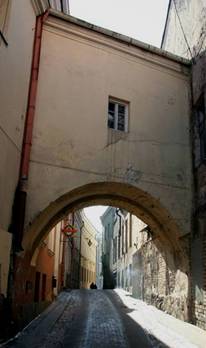
Here is what they write:
The Old Town of Vilnius (Lithuanian: Vilniaus senamiestis), one of the largest surviving medieval old towns in Northern Europe, has an area of 3.59 square kilometres (887 acres). It encompasses 74 quarters, with 70 streets and lanes numbering 1487 buildings with a total floor area of 1,497,000 square meters. The oldest part of the Lithuanian capital of Vilnius, it has developed over the course of many centuries, and has been shaped by the city's history and a constantly changing cultural influence. It is a place where some of Europe's greatest architectural styles – gothic, renaissance, baroque and neoclassical – stand side by side and complement each other. Pilies Street is the Old Town's main artery and the hub of cafe and street market life. The main street of Vilnius, Gediminas Avenue, is partially located in the Old Town
Read the article at:
http://www.flexijourney.com/blog/66-beautiful-small-cities-towns-in-europe/
- Bookmark :
- Digg
- del.icio.us
- Stumbleupon
- Redit it
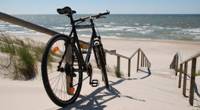
'Lithuania is yet to really take off with British visitors, which is all the more reason to head there,' says the newspaper...
'The country's big summer resort is Palanga - a fantastic 10km stretch of beach set against pine trees and sand dunes [which] remains a hotspot for the country's young and beautiful, well justifying its reputation as Lithuania's party capital.'
- Bookmark :
- Digg
- del.icio.us
- Stumbleupon
- Redit it
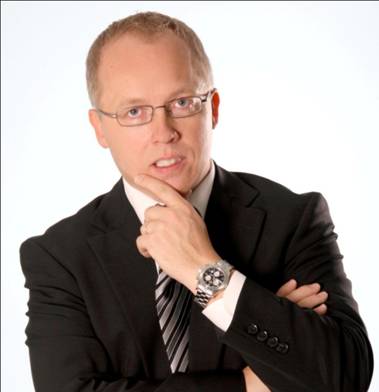
Palle Gravesen Jensen
A Danish expat to Lithuania, owner of two manufacturing companies, Electronic House and Metalco Baltic. Member of the board of the Danish Chamber of Commerce (DCC) in Lithuania. His family was one of the three families founding the Vilnius International School.
Text: Palle Gravesen Jensen
There are a number of issues to discuss with regards to Lithuania of today, the country I made my own 16 years ago, moving from my homeland Denmark.
One particular question, however, comes to my mind again and again: What is this country going to live on 20 years from now. It is a big question. My concern is there will not be much at all if nothing is done immediately.
Start with innovation
At DCC (Danish Chamber of Commerce) we recently took an initiative on innovation, by organizing an international conference, to try to understand whether there are creative products, ideas, businesses in Lithuania that could have potential export value. Because it is from innovation the real economic and income growth must come.
Let us not confuse the concepts of innovation and entrepreneurship. Entrepreneurship is about starting up businesses, not creating something. I myself am not an innovator, I am an entrepreneur.
Though from my earlier experience in Denmark I know that a lot of industries are driven by innovations. But there is a long pipeline: there has to be a favourable environment, starting from the education system. It also has to become socially acceptable to be an innovator – and to fail – because most innovators do fail, only a few pass through that little opening to success. When they do succeed, industries start building around them. This takes time, some 20 years, so if we in Lithuania want to be there in 20 years, we must kick off this innovation process today.
Why would innovators be socially unacceptable, one could ask? Well, I often hear people here saying: “I know this guy, he tried this and that, and he failed. What a fool! We could have told him that he would.'
Such an attitude kills innovation here. In the U.S., on the contrary, if you fail three times and succeed at the fourth attempt, nobody talks about those three attempts; they are simply seen as a maturing process leading to success in the end.
Today, Lithuanian biotech and laser firms are quite innovative, but I see no wide base for innovations to spread within these fields, not enough skilled engineers, plus a lot of barriers for foreign professional specialists to come here.
Politically I do not see a big wish to invite engineers from India, China or the U.S., there is no system to facilitate such exchanges, like the ones we have in Denmark.
I’ll leave Lithuania if progressive taxation is introduced
There are a lot of entrepreneurial start-up firms with staff of one to five persons here in Lithuania. I like that. What I do not like is that these entrepreneurs – and I know quite a few of them personally – are very proud when talking about how much taxes they avoid paying. A lot of their cash flow is black money.
That is my opinion like cancer to the entrepreneurship base. I find it very short-sighted that their main goal is to collect as much income as possible over the shortest time possible. Their business will never have any real value, and their growth potential will remain weak.
The fact is that taxation in Lithuania is fine. But the government should not push it harder, and not introduce progressive taxation.
If the progressive taxation system will be introduced, I would leave Lithuania instantly, and I know more businessmen would do the same.
I know of a specific case where a EUR 3m FDI investment project in IT services recently turned away from Lithuania and instead heading toward the other two Baltic States – only because the progressive taxation debate started here.
We have progressive taxes in Denmark. It is working but it is a mess, and there is no way back to a flat system. The biggest fault with progressive taxes is that one is being taxed so badly on the last part of the income that one is losing the motivation to do an extra effort. And innovation is a lot about that extra effort.
Barclay Bank’s ‘investment’ is a bad example of how to attract FDIs
I think the government’s support of the recent Barclay Bank’s investment here is a very bad example of how to attract FDIs to Lithuania.Their investmenthas nothing to do with innovation. They hire relatively inexpensive local IT staff, drain the local IT firms of talented young staff, and push salaries in the market up. It may be a flashy thing for the government to show to the world, but does Lithuania want to be a big back office, nothing more?
I know entrepreneurs from a few small IT firms here. They are crying their hearts out because their young software engineers, who had ideas and still being open-minded, opted for a higher salaries and safer jobs with companies like Barclays instead of staying with entrepreneur-innovator type of employers.
On the other hand, there is no support from the government to foster innovation in traditional manufacturing sectors, no effort to develop industrial parks suitable for innovative companies. There are a few so-called valleys in development for IT and biotech firms. But traditional industry is the base. Once innovations are developed, they will need support from traditional industry.
This government’s inactivity
Due to this government’s inactivity, we at DCC recently started developing clusters for various sectors, such as energy efficiency and innovation. These are not internal DCC initiatives – we only provide a launch pad for such ideas that we believe will develop on their own. But it is surprising that such initiatives do come not from Lithuanian organisations.
In general, Lithuania needs to make a real strategy for the next 10-20 years that would cover such fundamentals as education, infrastructure and social welfare.
Lithuania’s role as sub-supplier is coming to an end
Lithuania industry is today to a high degree a sub-supplier to Western industries, but this is a trend that soon will come to an end. My two companies are sub-suppliers, and every day I am doing my best to add value in all possible aspects – engineering, logistic solutions, warehouse management; taking over greater responsibility financially from our partners. Because if I am not able to adapt to the new times and challenges, then the only next step, at least in my industry, is to leave and find another country for my production activities.
I know for sure that exactly this will happen if we do not promote innovation. I myself do business with export markets, my clients are global innovative companies. I am very focused on getting my hook out on globally listed companies, such as 3M and ABB that are among my clients.
Sometimes such clients come themselves. We are, for instance, now starting to work with a new such company that has learned about us from the company Bombardier which we already are a supplier to.
90% of new business leads for my companies are generated by word-of-mouth advertising. For the first time in ten years we will now soon participate in an exhibition in Denmark.
EU funding systems do not work properly
Right now I am applying for EU aid to support our participation, but during the last couple of months I was very close to giving up. Because the system is not working. The aid agency is bureaucratic. The aid programmes are in constant change. Aid seekers have to spend big resources to adapt to the programmes instead of having programmes that are adapted to industry needs.
At the end of the day, this aid turns out to be twisting papers, moving money around, while the effect is minor.
In comparison, in Denmark a lot of aid money was injected into disadvantaged regions where we had structural problems like high unemployment rates and lack of jobs.
A good example is Vestas, the world's biggest wind mill turbine manufacturer. The company was established in one of those disadvantaged regions, and the EU money was invested in the development of local infrastructure, helping Vestas to attract skilled engineers and build a whole industry.
Increasingly complicated to find skilled labour
Internal training used to be enough to get skilled enough labour in this country. But now, as we would like to employ engineers with specific skills, I feel that this becomes rather complicated. I have talked to professors at the VGTU technical university in Vilnius and was told that engineers with such skills are not to be found here. So I am even considering filling these positions with Danish staff. I did employ welding engineers from Denmark before the crisis because the local market was drained. One reason was labour emigration, another one was that a lot of skilled employees went into the construction business to make quick money. So for a slightly higher salary I actually hired employees from Denmark with exactly those specifications that I needed. They would fly in, work for a week, then fly back home, then fly in again, and so on for some months.
In general, the government in Lithuania should put more focus on re-educating unemployed people. Another thing that could be done is to give a different status for those who simply are not fit to work – I have had such people sent to my companies by the local labour exchange. They should not be listed as available workforce.
I support the government’s plans to raise the minimum wage. When we hire blue-collar staff to do work that requires no specific skills, we start with a minimum wage of LTL 800 gross for the test period. If the wage is raised to LTL 1,000 as is debated today, it would put pressure on wages of all employees because skilled employees would then earn relatively less and demand more for their skills.
Therefore, the government should consider raising the tax-exempt minimum in order to raise the living standards. If the government is worried about budget revenue, means of collecting it are many but taxing labour too much is the worst path to follow.
I voted for Arturas Zuokas as Mayor of Vilnius
In the recent municipal elections here in Lithuania, I myself voted for the man who has now been re-elected Mayor of Vilnius, Arturas Zuokas. I know his background, I know all the negative stories about him but I think you could hear similar stories about most of the people in power here in this country.
As background for my choice I decided to focus on how the latest Vilnius Councils have been performing. The former council was simply sitting there waiting for the crisis to end, during a period when I believe there should have been made a lot of dynamic moves.
Vilnius was falling apart, and now needs the energetic guy back. Some of Zuokas' decisions will be wrong, some may be questionable, but there will be other decisions that will again push Vilnius forwards to a better future. Such as a metro system and a new airline for Lithuania.
I also hope that our government will take initiatives similar to those I believe Zuokas now will be taking, and that there finally will be serious focus on innovation as a basis for further development of Lithuania.
I would love to see a Lithuania that prospers today as well as in 20 years!
(This blog is based on an interview I gave to the business publication ‘news2biz’ in June 2011.)
- Bookmark :
- Digg
- del.icio.us
- Stumbleupon
- Redit it
VilNews e-magazine is published in Vilnius, Lithuania. Editor-in-Chief: Mr. Aage Myhre. Inquires to the editors: editor@VilNews.com.
Code of Ethics: See Section 2 – about VilNews. VilNews is not responsible for content on external links/web pages.
HOW TO ADVERTISE IN VILNEWS.
All content is copyrighted © 2011. UAB ‘VilNews’.

 Click on the buttons to open and read each of VilNews' 18 sub-sections
Click on the buttons to open and read each of VilNews' 18 sub-sections 







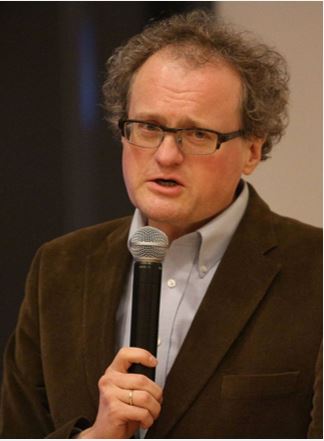
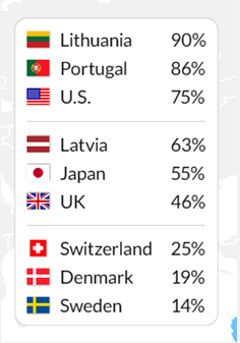
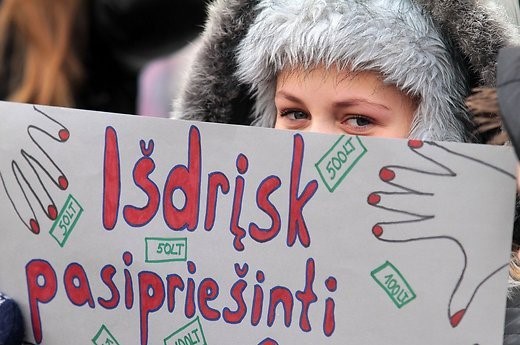


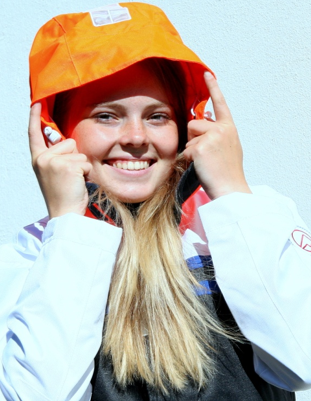
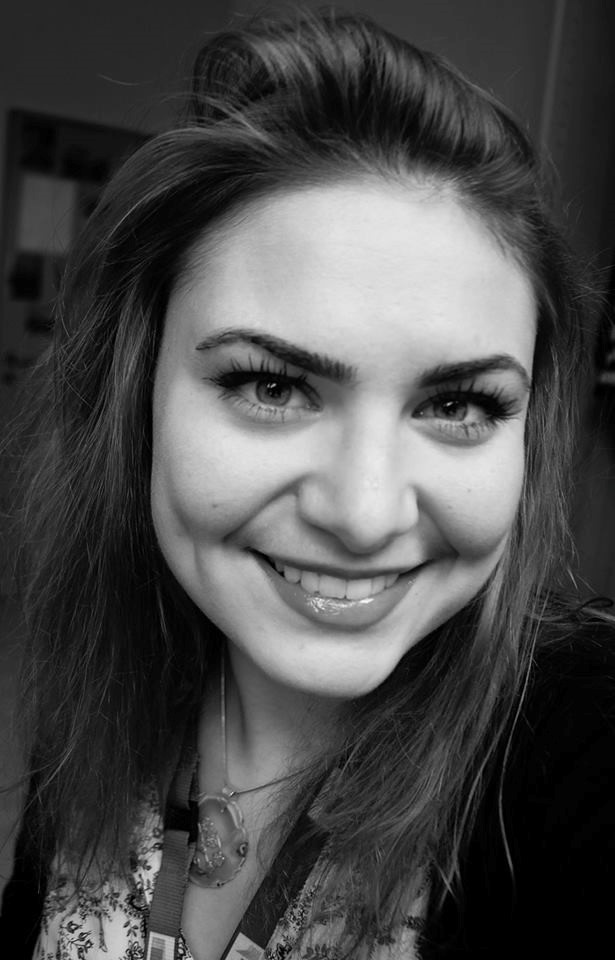
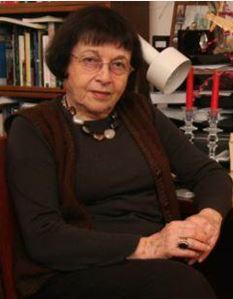
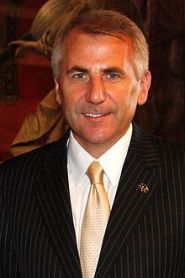
.jpg)
